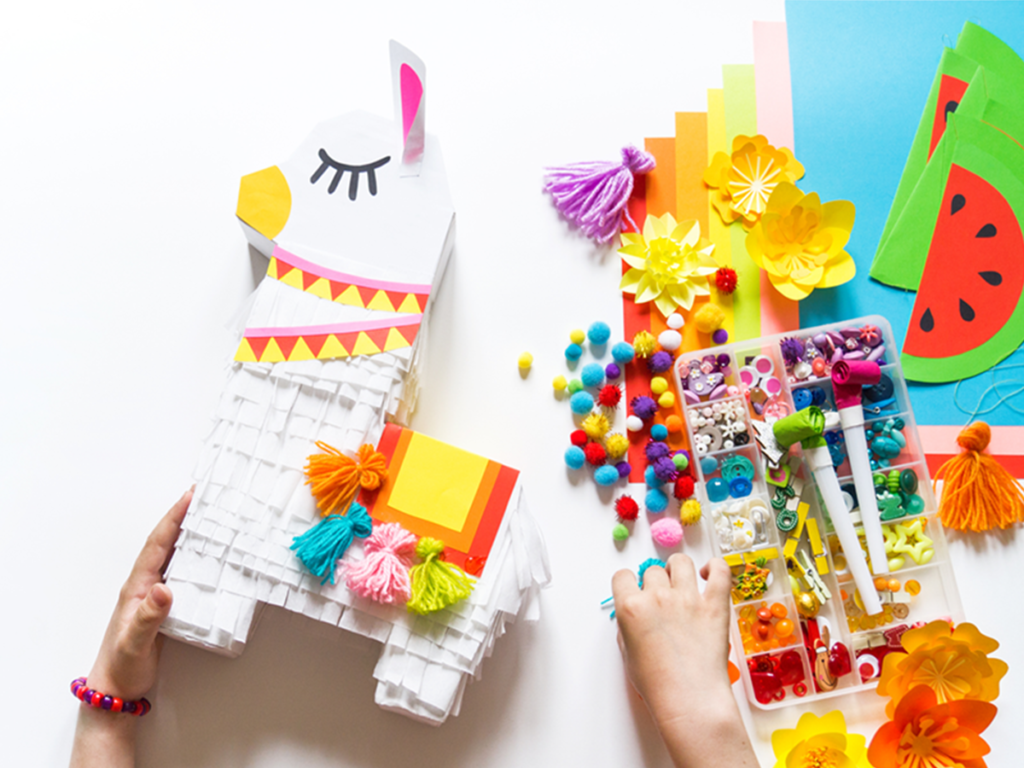Cinco de Mayo is a day set aside to celebrate Mexico’s monumental victory over the French in 1862. On May 5, Mexicans celebrate with parties, parades and other festivities. Even if you don’t have a Hispanic heritage you can celebrate with these activities.
SHOWY SERAPE
A serape is a colorful wool blanket or shawl worn by Mexicans.
Items needed: large brown paper bag with flat bottom, scissors, pencil, ruler, old newspaper, paintbrushes, tempera paints (bright colors), hole punch, colored yarn cut in six-inch pieces.
- Open up the large bag and cut straight up the back seam.
- About two-thirds of the way up the bag, branch out into a “V,” gradually shifting to an arch shape when you reach the bottom of the bag, so your head and shoulders can fit through.
- On both sides of the bag, cut out armholes measuring approximately 4 inches long by 5 inches wide.
- Place the paper serape over old newspaper and paint the outside with large, bright stripes using different colored paints.
- When dry, punch holes about one-half inch from the bottom edge, making them 1 inch apart.
- String three pieces of yarn through each hole and tie in a knot.
ETERNAL EYES
“Ojo de dios” is an ancient symbol used by Mexican Indians to remind them that God was watching over and protecting them.
Items needed: two Popsicle sticks, different colors of yarn, scissors, glue.
- Place Popsicle sticks together to form a “plus” sign then glue together to make the frame.
- Let dry.
- Working in order, assign a number (1, 2, 3, 4) to each of the four sides.
- Take a long piece of yarn and wrap it around side 1; tie a knot in the back to secure and push close to the center of the frame.
- Wrap the free end of that piece of yarn around side 2, close to the center frame.
- Repeat this step with sides 3 and 4 so the yarn is back to side 1.
- Continue to wrap around each side, making sure you always wrap in the same direction and pushing the yarn close together.
- After about 10 rotations, tie off the yarn and change to a new color, following the same procedure.
- Use three colors or more until the frame is full.
PAPER POSIES
Items needed: tissue paper (bright colors), pipe cleaners, scissors, ruler.
- Cut tissue paper into rectangles measuring 6 by 8 inches.
- Stack eight pieces of tissue paper, then take the long side of the stack and begin making accordion pleats that are approximately three-fourths inch wide.
- Wrap one end of the pipe cleaner around the center of the accordion pleated paper.
- Twist to secure in place.
- Carefully separate paper layers, pulling them up toward the center.
- Repeat steps 2 through 4 to make more flowers.
PRIZE-PACKED PIÑATA
Items needed: large paper bag, wrapped candies, small toys and coins, old newspaper, stapler, hole punch, string, tissue paper, glue, scissors, crepe paper streamers.
- Fill the paper bag about one-third full of goodies.
- Crumble up old newspapers to add fullness and finish filling the bag.
- Fold down the bag opening and staple shut.
- Punch two holes along the top.
- Cut strips of tissue paper that fit all the way around the bag.
- Fringe strips to about half-way up the width of the tissue paper.
- Starting at the bottom of the bag glue the tissue paper in place.
- Repeat the last two steps with different colored tissue paper, gluing from the bottom up until the entire bag is covered.
- Tie a long string through the two top holes to hang the piñata.
- Glue long pieces of crepe paper from the bottom.
REVELING READS
- “Cinco de Mayo” by Lola M. Schaefer.
- “De Colores and Other Latin-American Folk Songs for Children” by Jose-Luis Orozco.
- “Horse Hooves and Chicken Feet: Mexican Folktales” by Neil Philip.
- “Cooking the Mexican Way” by Rosa Coronado.
- “Mexico & Central America: A Fiesta of Cultures, Crafts, and Activities for Ages 8-12” by Mary C. Turck.
FUN FACTOID: Viva Mexico!
Some people think Cinco de Mayo is to Mexico what the Fourth of July is to America. But it’s not. Mexican Independence Day is actually celebrated on September 15, when in 1821 the Mexicans declared freedom from Spanish rule. Forty years later, however, the country’s independence was threatened when a French army of 8,000 under the rule of Napoleon III came up against 4,000 Mexican soldiers. On May 5, 1862, the Mexicans valiantly fought and defeated the French at the Battle of Pueblo.
Since that time, Cinco de Mayo has become a celebratory event among Mexicans and even Americans. Festivities include parades, parties, carnivals, battle reenactments, cultural food, mariachi music and folk dancing. Mexico’s colors – red, white and green – are also an integral part of the celebration.
Related
The Significance of Quinceañeras
Fun Birthday Party Places for Busy Parents

